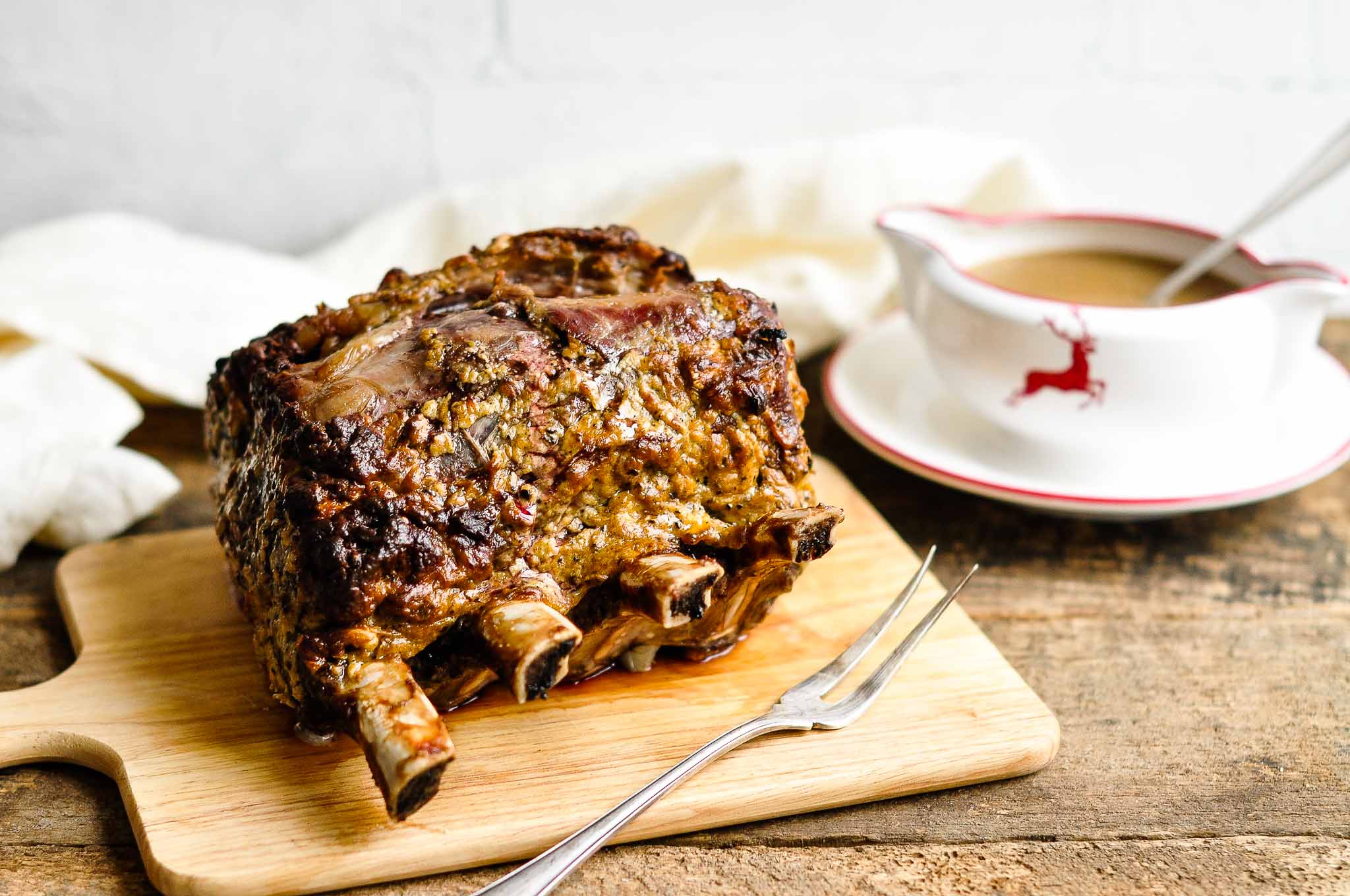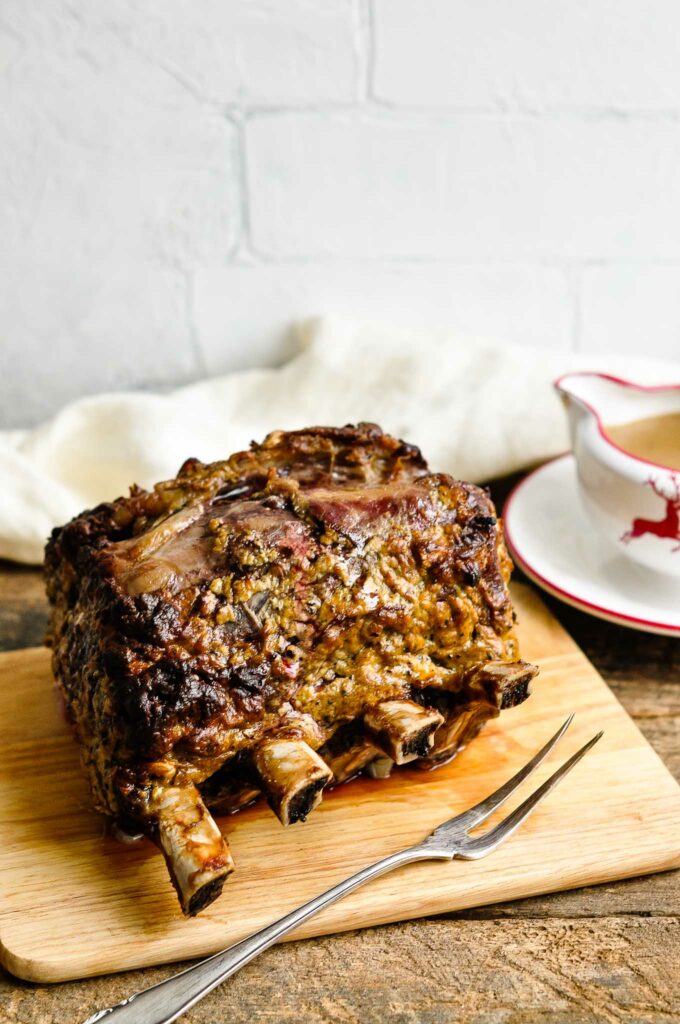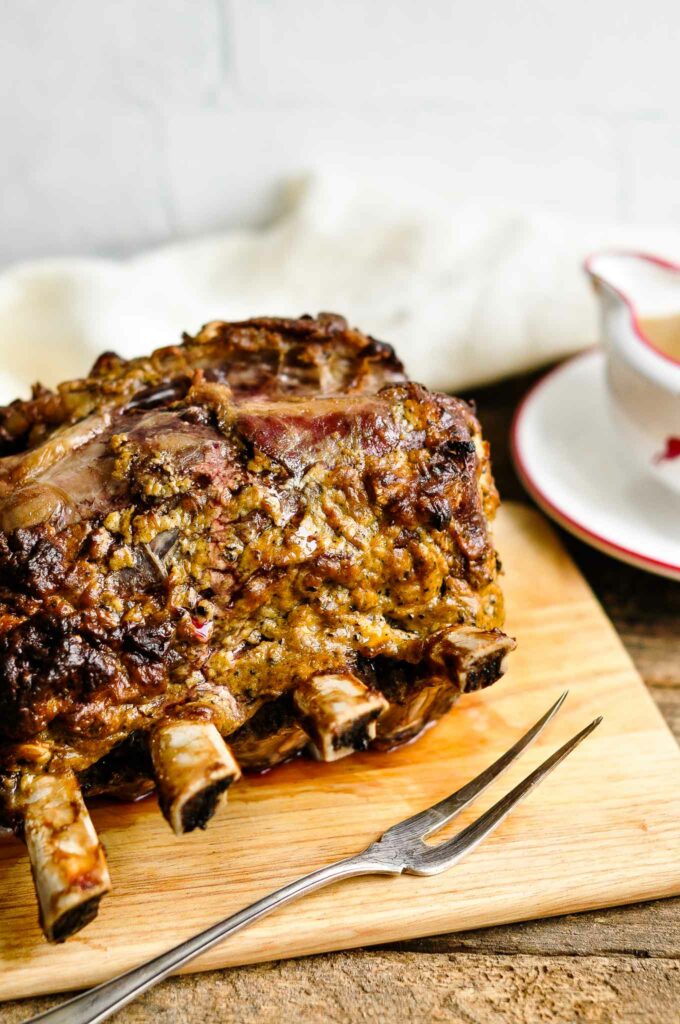For a special meal with friends and family, nothing is more inviting than a classic Beef Rib Roast, served with Crispy Roast Potatoes and your favourite gravy. My tips and tricks for making the perfect roast beef!

Standing Beef Rib Roast
For the ultimate roast beef, it is hard to go past a Beef Rib Roast, also called a Standing Rib Roast or a Prime Rib Roast. Meat which is cooked on the bone has a lot more flavour and moisture, and there is something very decadent about bringing a standing rib roast to the table.
Many people are intimidated to cook with a large piece of meat, whether it is a fillet of beef or a large piece of meat on the bone. But practice makes perfect, and what I have to come realise is that making a roast beef is no different to grilling a piece steak. Both cuts of meat require the same cooking technique, except, of course, the larger the piece of meat, the longer the cooking time.

Beef Rib Roast Recipe
When making roast beef, I like to keep it pretty simple so that the beef can shine, especially when you are spending a lot of money on a cut like a standing rib roast. I will generally only season the beef with salt and pepper – nothing else. After all, it is the side dishes and the gravy which will add any additional flavour to the overall dish.
But once you become confident at making roast beef, you can play around a bit with the seasoning. For example, I sometimes like to generously season the outside of the beef with freshly cracked pepper (think Steak with Peppercorn Sauce).
At other times, I will spread a thin layer of Dijon mustard onto the seared beef, which will form a mildly spicy crust as the meat roasts (see photos for this recipe). If you are someone who likes to eat your roast beef with mustard, this recipe variation may be for you.
But generally, I think it is best to keep the beef simple – you will most likely need to devote more time and attention to the accompanying dishes.
Cooking Times & Temperatures for Roast Beef
Whether you a roasting a fillet of beef or meat on the bone, such as a standing rib roast, the same cooking technique applies.
- Season the meat with sea salt and freshly cracked pepper.
- Sear the meat in a hot pan with oil until golden and caramelised.
- Cook the beef until about 5°C/40°F less than the desired internal temperature.
- Let the meat rest for about half the cooking time. During this time, the meat will continue to cook from the residual heat and gradually reach the target internal temperature.
I like to sear the meat first on the stove so that the meat becomes golden and caramelised on the surface, before finishing the cooking in the oven.
When making a Beef Rib Roast, please use the following approximate cooking times and temperatures. As the meat is resting, it will continue to cook and generally increase another 5°C/40°F. However, much depends on where the meat is resting, and the temperature of your kitchen. Ideally, remove the meat to a large wooden board or large platter, rather than leave the meat to rest in the hot roasting pan.
I recommend using a digital meat thermometer when roasting beef (with or without bone) to eliminate any guess work on when the meat has been cooked to your liking.
| Cooking Style | Cooking Time for Beef on the Bone | Cook Until | Target Internal Temperature |
| Rare | 35 mins per kg/15 mins per lb | 45°C/113°F | 50°C/122°F |
| Medium | 45 mins per kg/20 mins per lb | 55°C/131°F | 60°C/140°F |
| Well Done | 70 mins per kg/30 mins per lb | 65°C/149°F | 70°C/158°F |

Tips for Cooking a Roast Beef
- Use a probe thermometer. A probe thermometer is an easy way to tell if the meat has been cooked to your liking. This will save you from having to poke or pierce the meat, which will invariably still involve some guess work. There are different types of digital thermometers available, and I think the most popular is an instant read thermometer, i.e. one which you insert into the meat to see the temperature reading.
- Use an oven-proof digital meat thermometer. An oven-proof digital meat thermometer is my preferred thermometer when roasting any kind of meat. You insert the probe into the thickest part of the meat, and the probe is attached to a heat-resistant wire which is connected to the thermometer unit, which remains outside of the oven. With such a device, you can easily see the current temperature of the meat, and you can even set an alarm for the device to beep when the meat has reached your desired temperature. This thermometer will completely eliminate any guess work, and I find it to be the easiest and most stress-free way to roast meat.
- Undercook the meat slightly. As you rest the meat (see below), the meat will continue to cook from the residual heat as it sits. So aim to finish cooking at about 5°C/40°F less than your desired internal temperature. Once the meat has finished resting, it should gradually reach the target internal temperature.
- Rest the meat. Resting the meat will allow all of the juices to run back to the centre of the meat, ensuring that the meat will be tender and moist. If you slice into the meat too soon, all of the juices will flow out of the meat, resulting in dry meat. The general rule is to rest the meat for half the cooking time.

Beef Rib Roast
- Resting Time: 30 minutes
- Prep Time: 10 minutes
- Cook Time: 2.5 hours
- Total Time: 0 hours
- Yield: Serves 8 to 12
- Category: Dinner
- Method: Oven
- Cuisine: Australian, British
For a special meal with friends and family, nothing is more inviting than a classic Beef Rib Roast, served with Crispy Roast Potatoes and your favourite gravy.
Ingredients
- 4-rib joint of beef, about 3-4 kg (7–9 lb)
- sea salt
- freshly cracked black pepper
- 2–3 tablespoons olive oil
- 2–3 brown onions, sliced into thick rings
- 4–5 sprigs of rosemary
Instructions
- Place the meat on a large plate or tray, and let it come to room temperature. This should take about 30-60 minutes, depending on the size of your meat and the temperature in your kitchen.
- Season the meat all over generously with sea salt and freshly cracked black pepper.
- Preheat the oven to 220°C/428°F (without fan).
- If you have a large roasting pan which is also suitable to use on the stove, place this on the stove over medium-high heat. Otherwise, use a large saucepan.
- Add the oil to the pan.
- Sear the meat on all sides until it has browned and caramelised nicely.
- Remove the meat to a large plate or tray to let it rest while you prepare the next few steps.
- Remove the roasting pan from the stove.
- Place the onions in a single layer on the bottom of the roasting pan.
- Sprinkle over a few sprigs of rosemary.
- Place the meat on top of the onions and rosemary.
- If you have an oven-safe meat thermometer (such as an oven-proof digital meat thermometer), insert the needle into the centre of the meat.
- Place the roasting pan on the middle rack of the oven.
- Roast the meat until it is cooked to your liking. If you like your meat cooked medium, this should take approximately 45 minutes per kilo/20 minutes per pound, and the temperature reading should be around 55°C/131°F. As the meat rests, it will continue to cook from the residual heat and gradually reach 60°C/140°F. If you like your meat cooked rare or well-done, please see the table below.
- Let the meat rest on a wooden board before carving. This will allow all of the juices to flow back to the centre of the meat, which will make the meat more tender and moist. Ideally, you should let the meat rest for half the cooking time, but I think 30 minutes is generally good enough. You can wrap the meat in foil during the resting time to help keep the meat warm.
- To carve, I find it easiest to slice each rib off the rack, carefully remove the bone, and then slice the meat against the grain into slices (thick or thin, as you prefer).
- Reserve any meat juices from carving or resting the meat, and add this to your gravy, such as Jamie Oliver’s Get Ahead Gravy.
Kitchen Notes
 COOKING TIMES & INTERNAL TEMPERATURES FOR ROAST BEEF ON THE BONE
COOKING TIMES & INTERNAL TEMPERATURES FOR ROAST BEEF ON THE BONE
Aim to stop cooking the meat at 5°C/40°F less than the following stated temperatures. This is because the meat will continue to cook as it rests.
* Rare: 35 mins per kg/15 mins per lb, 50°C/122°F
* Medium: 45 mins per kg/20 mins per lb, 60°C/140°F
* Well Done: 70 mins per kg/30 mins per lb, 70°C/158°F
 VARIATIONS
VARIATIONS
* Just before roasting, generously sprinkle the surface of the meat with lots of freshly cracked black pepper.
* Just before roasting, spread a thin layer of Dijon mustard over the top surface of the beef, followed by lots of freshly cracked black pepper.
 OVEN & STOVE TEMPERATURES
OVEN & STOVE TEMPERATURES
All recipes on this website have been tested on an induction stove and/or with a conventional oven (i.e. an oven without fan). All recipes on this website use temperatures for a conventional oven, unless otherwise mentioned. Convection ovens (i.e. fan-forced ovens) are typically 20°C/70°F hotter than conventional ovens, but please check your manufacturer’s handbook.
 CONVERSIONS
CONVERSIONS
To convert from cups to grams, and vice-versa, please see this handy Conversion Chart for Basic Ingredients.
 Print
Print Pin Recipe
Pin Recipe Rate
Rate